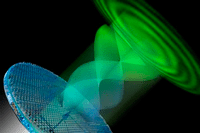 Structured beams of light which exhibit strange behaviour could have such applications as super-resolution imaging and communications, according to researchers the Harvard School of Engineering and Applied Sciences, who have have developed a tool to generate new states of light in a different way.
Structured beams of light which exhibit strange behaviour could have such applications as super-resolution imaging and communications, according to researchers the Harvard School of Engineering and Applied Sciences, who have have developed a tool to generate new states of light in a different way.
“We have developed a metasurface; a new tool to study novel aspects of light,” said Professor Federico Capasso. “This optical component makes possible much more complex operations and allows researchers to not only explore new states of light, but also new applications for structured light.”
The metasurface is said to connect two aspects of light: orbital angular momentum; and circular polarisation, or spin angular momentum.
While the fact that light can carry orbital momentum is said by the team to be a relatively recent discovery, it’s this property which enables beams in the shape of corkscrews. Previous research has used polarisation to control the size and shape of beams, but the connection was limited because only certain polarisations could convert to certain orbital momentums.
“This metasurface gives the most general connection, through a single device, between the orbital momentum and polarisation of light that’s been achieved so far,” said researcher Robert Devlin.
The device can be designed so that any input polarisation of light can result in any orbital angular momentum output. This means any polarisation can yield any kind of structured light – such as spirals, corkscrews and vortices of any size. The device can also be programmed so that one polarisation results in one vortex and a different polarisation results in a completely different vortex.
Alongside high-powered imaging, the development could find application in free space optical communication, especially in scattering environments. It has also been shown that similar elements could be incorporated into lasers. “This may lead to unforeseen applications,” said researcher Noah Rubin.
Author
Graham Pitcher
Source: www.newelectronics.co.uk

